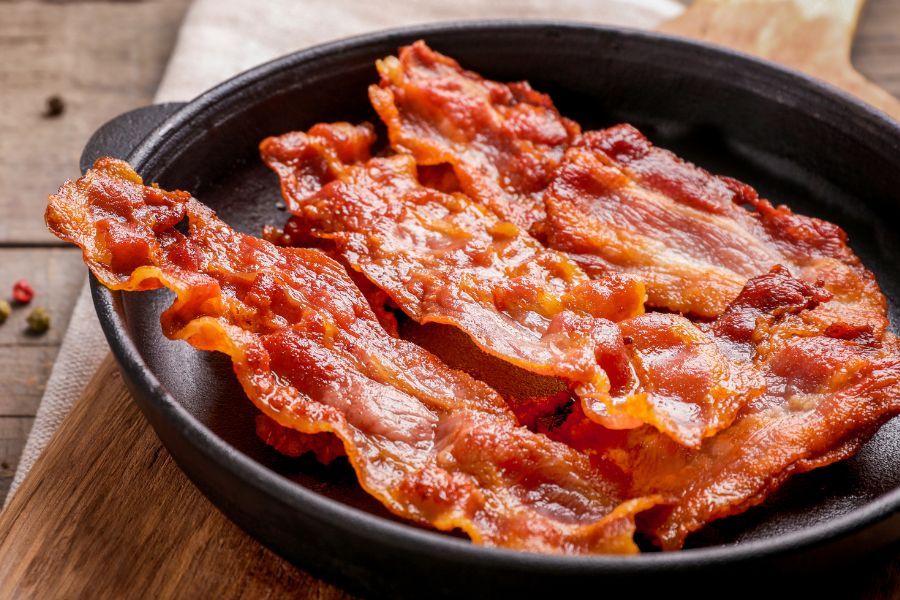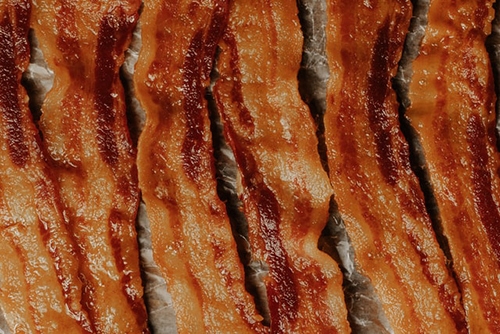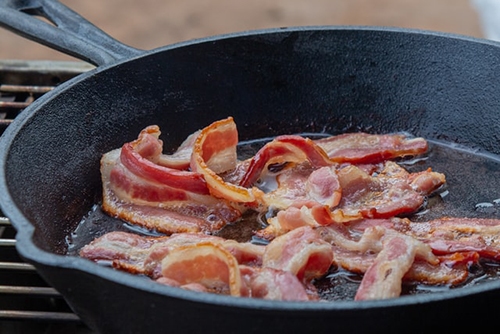Bacon is usually done when it is a light brown color, although you can also look at the texture and level of grease as well.
I’m constantly asked: how do you know when bacon is done? You think we would have figured it out by now considering how often people prepare bacon. Luckily for you, Ive had pros show me the way and I’m now here to share it with you.
In this post you can discover the signs that bacon is done, how to cook it, and a whole lot more. So, let’s begin!

Did you know that there are as many as fourteen types of bacon?
Now, what you are probably most familiar with – and cook with in most cases – is streaky bacon. That being said, it is a good idea to consider the kind of bacon that you are cooking with beforehand.
Bacon can vary in terms of thickness, fat or grease content, whether they are bacon pieces or slices, and a whole lot more. As such, they will each be considered “done” at their own rate and time.

One of the trickiest thing about cooking bacon is that bacon cooks quickly – very quickly in fact. As such, it is a fine line between undercooked and cooked enough. It is just as minor of a difference between well done and overdone.
This is why it is important to monitor your bacon carefully during the cooking process. Take your eye off of it at a critical moment and you could have a mess on your hands.
It is an interesting question, though, when is bacon actually considered cooked to perfection?
Now, a lot of people may say that it is when you end up with crispy bacon – the crispier the better. At the same time, however, you have to consider personal preferences.
Some may prefer their bacon ultra-crispy. On the other hand, there may be those that consider that the bacon is cooked when it is safe to eat and not a moment longer.
This is why it is a good idea to try out various cooking methods, times, and more when it comes to cooking bacon. It is only with practice and experimentation that you will be able to figure out what works for you.
If you keep undercooking your bacon, you may be wondering if it is safe for you to eat it?
Well, it turns out that consuming raw bacon or undercooked bacon is just like consuming other types of raw meat – it can increase your risk of food poisoning. What is just as interesting, though, are the consequences of overcooking your bacon. It turns out that burnt bacon has a higher content of carcinogens called nitrosamines.
Thus, it is important to make sure that your bacon is cooked to the right point.
The cooking time depends on a few different factors, including the cooking method and thickness of the meat.
For regular cut bacon slices, it can take as little as 4 to 6 minutes on the stovetop and as much as 12 to 20 minutes in the oven. As for extra thick slices, it can take up to 10 minutes or more on the stove and 25 minutes or longer when baked.
Of course, what you want to really know is how to tell when bacon is done cooking. Here are some of the common tell-tale signs:
The best way to know if bacon is done is by looking at the color of the meat. Raw bacon is light pink in color – if there is any pink on your bacon. Then, these portions haven’t been cooked through.
Now, when the bacon slices are golden brown, you may think that they are done, but they still need to continue to cook until it is a darker shade. It is only when they are light brown that they are cooked properly.
In most instances, dark brown is considered burnt, but there are plenty of people who like their bacon like this so it really is up to you.
This method isn’t nearly as reliable but it can be considered a distinguishing feature to pay attention to.
As you cook bacon, it begins to release moisture and the fat is rendered out. As this happens, shrinkage takes place. It is possible for a slice of bacon to shrink as much as 40 percent.
It is a good idea to look at the shape of the bacon as well. When it is first placed on the pan, it is going to be relatively straight and flat. As you cook the bacon, it will begin to curl and appear wavier. So much so that certain sections may lift away from the surface.
If you have ever taken bacon out of its packaging with your fingers, then you know it can feel slimy to the touch. Once you cook bacon, though, it should be completely dry. Yes, while it is in the pan, it will be surrounded by grease. Blot it with some paper towels, however, and it should feel dry to the touch.
When you are cooking bacon, you may notice some white foam surrounding each strip. This is the fat being rendered out. It is typically a sign that you should flip the strip over as well. When the foam begins to fade, it is an indication that the bacon has finished cooking.
Finally, there is the texture. Once again, this will not be as accurate as the color, but it is still some thing to keep track of. The other thing that you should keep in mind is that each person has their own preference for the level of crispiness. Thus, you need to figure out your desired texture and how to achieve it.

When the bacon is slightly crispy, it is still not done enough and needs to be cooked further. When it is crisp and firm, the bacon is done.
As mentioned, there are some who prefer a greater level of crispness. Thus, you may only want to stop cooking the bacon when it is practically brittle.
Related Reading
Here are some of the tips that you should follow when cooking bacon. Keep in mind that most of these apply to cooking bacon on the stove:
Yes, there is such a thing as the right pan for cooking bacon and this is the cast iron skillet. This is because it cooks the bacon at the right temperature and ensures that the bacon strips don’t get stuck to the pan.
In turn, the grease from the bacon acts as seasoning for your cast iron skillet. Thus, it is a win-win situation. Now, a non-stick frying pan can work quite well, but the temperature can end up getting a bit too high and you run the risk of not cooking your bacon evenly.
You should never cook cold bacon that has been just taken out of the refrigerator. Understand, for the meat and the fat in the bacon to cook evenly, they must be the same temperature. The issue, though, is that fat tends to retain the cold for longer. Thus, it will cook at a slower rate.
It is a good idea to take the bacon out at least 15 minutes before you plan on cooking it and let it sit out on the counter.
It ca be tempting to try to cook as much bacon as you need in one go, but this will be a mistake. For one thing, it is vital that every inch of the bacon slices are making contact with the surface of the cookware. This ensures more even cooking.
For another, the bacon needs space to properly cook through. Due to this, you should always arrange the slices in a single layer, with a little bit of space in between each strip.
When cooking or frying anything, including bacon, your go-to move is probably to heat up the cookware and then add the food. This isn’t the case with bacon, however. A hot skillet runs the risk of cooking the delicate bacon too quickly. If this happens, the fat will not render and there will be uncooked spots.
To avoid this, always place the bacon strips on a cold pan or cold skillet and then heat it up.
On a similar note, make sure to cook the bacon on a low heat. This way, you reduce the risk of uneven cooking or burning the bacon to a crisp.
Now let’s break down how to cook bacon using a variety of cooking methods:
Place the bacon strips on a cold skillet, place on the fire, and set to low-medium heat.
Now, there are some people who add water to the pan ahead of time. This is so that the fat renders a little better and creates a better texture. This isn’t really a necessary step, though. And, in some cases, it can make for a messier cleanup as the watery grease dries up and sticks to the pan.
Watch the bacon as it cooks and pay closer attention to the strips as it turns a golden brown. Once the residue surrounding the strips appears, you can flip the bacon over to the other side. When the residue begins to fade from here as well and the bacon is a proper color, it is time to remove it from the heat.
This is the best cooking method for when you want to prepare bacon for a larger number of people.
As with the stovetop, it is best to get a cold start and then heat up the oven. 400 degrees Fahrenheit tends to be a good heat. 375 degrees is just a little too cold and anything above 425 degrees will result in burnt bacon.
When baking the bacon, you have two options – wire rack or baking tray. While the wire rack can be great for texture, I have found that it can be quite a bit of work. For one thing, you have to place a baking dish underneath to catch the grease. For another, once you are done, you then have to scrape the grease off the rack.
A far better option is to line the tray with aluminum foil. Then, crimp it into ridges so that the bacon is lifted up and create valleys where the bacon grease can drain away.
Only ever grill extra thick bacon slices. The thin ones will not do and will get scorched far too quickly.
If you are grilling the bacon, then you will need to set you two zones on your grill. One should have direct heat and the other indirect heat.
When you place the bacon the grates, make sure that it straddles the line of the direct and indirect heat. This way, the strips get a nice sear but avoid getting overcooked thanks to the medium hot fire.
My advice to you is to avoid putting bacon in the microwave. Sure, it will cook it through – enough so that it is safe to eat. And, at a glance, it may even appear that the bacon is brown and crispy.
Once you go to take a bite, though, you realize that the texture and taste is off. There is no reason to opt for this method when you have so many others to choose from.